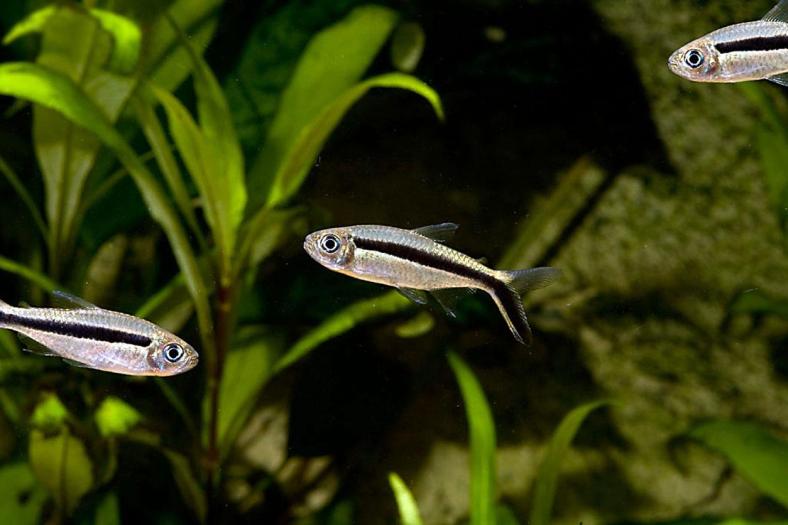
Thayeria boehlkei, known as the hockeystick tetra or penguin tetra. (Image Credit: Unknown; sourced from http://www.free-pet-wallpapers.com)
On this lazy Sunday afternoon I am watching ice hockey on television. The Pittsburgh Penguins are playing against the Ottawa Senators in the National Hockey League (NHL) Stanley Cup Playoffs — and I realized the perfect species to profile today would be one named after both hockey sticks and penguins.
Thayeria boehlkei is known in the aquarium trade variously as hockeystick tetra, penguin tetra, penguin fish or blackline penguinfish, after the black markings on its body. It grows to about 3 inches (7.6 cm), and hails from the Amazon and Araguaia river basins of South America. Thayeria obliqua and Thayeria ifati are related species which share similar black markings and also are referred to as “penguin fish”.
The “penguin fish” moniker also refers to its odd habit of hovering at a head-up, oblique angle:

Thayeria boehlkei, the penguin fish, resting at a positive oblique angle. (Image Credit: Unknown; sourced from wereallwet.com)
I found a masters thesis from 1979 where the author experimented with Thayeria boehlkei, Thayeria obliqua, and several other fish species to figure out how they maintain this unique posture.
The study involved some old-school methods, mainly removing caudal fins and pectoral fins and then seeing how the fish swam without one or the other, though the author did note that most fish regenerated the lost fins within weeks (“… except for the pectoral fin amputations in Nannostomus eques, which caused 100% mortality after about a week.”).
Thayeria boehlkei was found to have a center-of-mass naturally behind its center-of-buoyancy, meaning that if the fish was motionless, it would float slightly head-up. Loss of the caudal fin additionally hampered the fish’s ability to maintain its preferred head-up posture, causing the body to tilt even further — leading the fish to swim more actively to maintain its posture (Chondoma 1979).
But why rest heads up? Penguin tetras prefer to hover and feed near the water surface — which can make them more vulnerable to predators stalking them from below — but they do revert to a more typical, non-tilted posture when swimming rapidly.
The author postulated that this switch in posture between heads-up hovering and normal swimming results in a minor change in escape trajectory — a head-fake, to use ice hockey parlance — that allows penguin tetras a tiny, extra moment to flee a predator lunging from below (Chondoma 1979).
Now back to this game — still tied 1-1 and heading into second overtime! One of the Penguins needs to do a nice head-fake and score…
And here is your Random Fish Video Set to Crazy Soundtracks — this one set to a particular vintage genre:
Thayeria boehlkei Weitzman, 1957
Hockeystick Tetra
Click for name etymology (ETYFish Project)
Click for names in other languages (FishBase)
Class Actinopterygii (Ray-finned Fishes)
Order Characiformes (Characins)
Family Characidae (Characins and Tetras)
FishBase Page: http://fishbase.org/summary/10716
Citations:
–- Ben Young Landis
WHAT ARE THE DIFFERENCES BETWEEN THE MALE AND FEMALE PENGUIN/OCKEY STICK FISH
Thanks for your question! As far as I know, there are no obvious differences between the appearance of males and females of hockeystick tetras. Females are probably more rounded in the belly. In other “tetra” species, there can be more distinct differences.